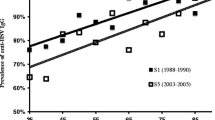Abstract
This study investigated risk factors for herpes simplex virus type 1 (HSV-1) infection in a population of university students in Germany and Spain. In addition, factors associated with the occurrence of oral lesions were studied. Serum samples were collected from 596 Spanish students from the Navarra Public University in Pamplona and 174 German students from the University of Bielefeld aged 17–41 years and tested by a HSV-1 type-specific immunoassay using monoclonal antibody-selected gG1 as antigen. Information on clinical manifestations and risk factors were obtained by a standardized questionnaire. The rate of HSV-1 infection was 55.3 and 27.4% of these infected students reported having had oral lesions within the last 12 months. Prevalence of HSV-1 infection did not differ between study sites, and did not vary according to gender or age. Students with coitus experience were more likely to be infected with HSV-1 (Odds ratio (OR), 1.88; 95%CI: 1.31–2.69), while other lifestyle factors were not associated with HSV-1 infection. Risk factors for the occurrence of oral lesions included HSV-1 seropositivity (OR: 6.90; 95%CI: 3.84–12.37) and a higher level of perceived stress, as measured by the Cohen scale of perceived stress (OR: 1.79; 95%CI: 1.15–2.78). Drinking alcohol was found to be a protective factor (OR: 0.59; 95%CI: 0.37–0.93). There was no difference in the clinical pattern and course of infection between the young adults in Germany and Spain. We conclude, that lifestyle factors appear to play an important role in the epidemiology and clinical manifestations of HSV-1.
Similar content being viewed by others
References
Gil A, Gonzalez A, Dal-Re R, Ortega P, Dominguez V. Prevalence of antibodies against varicella zoster, herpes simplex (types 1 and 2), hepatitis B and A among Spanish adolescents. J Infect 1998; 36: 53–56.
Wutzler P, Doerr HW, Färber I, et al. Seroprevalence of herpes simplex virus type 1 and type 2 in selected German populations – relevance for the incidence of genital herpes. J Med Virol 2000; 61: 201–207.
Embil JA, Stephens RG, Manuel FR. Prevalence of recurrent herpes labialis and aphthous ulcers among youngadults on six continents. Can Med Assoc J 1975; 113: 627–630.
Miller CS, Danaher RJ, Jacob RJ. Molecular aspects of herpes simplex virus I latency, reactivation, and recurrence. Crit Rev Oral Biol Med 1998; 9: 541–562.
Dalkvist J, Robins Wahlin T-B, Bartsch E, Forsbeck M. Herpes simplex and mood: A prospective study. Psychosom Med 1995; 57: 127–137.
Glaser R. Kiecolt-Glaser JK. Chonic stress modulates the virus-speci.c immune response to latent herpes simplex virus type 1. Ann Behav Med 1997; 19: 78–82.
Logan HL, Lutgendorf S, Hartwig A, Lilly J, Berberich SL. Immune, stress, and mood markers related to recurrent oral herpes outbreaks. SurgOral Med Oral Pathol Oral Radiol Endod 1998; 86: 48–54.
Longo DJ, Clum GA, Yaeger NJ. Psychosocial treatment for recurrent genital herpes. J Consult Clin Psychol 1988; 56: 61–66.
Cohen S, Kamarck T, Mermelstein R. A global measure of perceived stress. J Health Soc Behav 1983; 24: 385–396.
Stock C, Wille L, Krämer A. Gender-specific health behaviors of German university students predict the interest in campus health promotion. Health Prom Int 2001; 16(2): 145–154.
Ashley RL, Militoni J, Lee FK, Nahmias A, Corey L. Comparison of Western blot (immunoblot) and glycoprotein G-specific immunodot enzyme assay for detectingantibodies to herpes simplex types 1 and 2. J Clin Microbiol 1988; 26: 662–667.
Cowan FM, Johnson AM, Ashley R, Corey L, Mindel A. Antibody to herpes simplex type 2 as serological marker of sexual lifestyle in populations. Br Med J 1994; 309: 1325–1329.
Hashido M, Lee FK, Nahmias AJ, Tsudami H, Isomura S, Nagata Y, Sonoda S, Kawana T. An epidemiologic study of herpes simplex virus type 1 and 2 infection in Japan based on type-specific serological assays. Epidemiol Infect 1998; 120: 179–186.
Toba K. Seroepidemiology of herpes simplex virus infections. In: Mori R, Kawana T (eds.) Infections with herpes simplex virus. Tokyo: Medical Tribune, 1986, 161–172.
Conde-Glez CJ, Juarez-Figueroa L, Uribe-Salas F, et al. Analysis of Herpes simplex virus 1 and 2 infection in women with high risk sexual behaviour in Mexico. Int J Epidemiology 1999; 28: 571–576.
Andersson-Ellstrom A, Svennerholm B, Forssman L. Seropositivity to herpes virus type 1 and 2, cytomegalovirus and Epstein-Barr virus in teenage girls. Scand J Infect Dis 1995; 27: 315–318.
Andria GM, Langenberg A, Corey L, Ashley RL, Leong WP, Straus SE. A prospective study of new infections with herpes simplex virus type 1 and type 2. New EngJ Med 1999; 19: 1432–1438.
Lafferty WE, Downey L, Celum C, Wald A. Herpes simplex virus type 1 as a cause of genital herpes: Impact on surveillance and prevention. J Infect Dis 2000; 181: 1454–1457.
Laubereau B, Zwahlen M, Neuenschwander B, Heiniger U, Schaad UB, Desgrandchamps D. Herpes simplex virus type 1 and 2 in Switzerland. Schweiz Med Wochenschr 2000; 130: 143–150.
Glaser R, Kiecolt-Glaser JK, Speicher CE, Holliday JE. Stress, loneliness, and changes in herpes virus latency. J Behav Med 1985; 8: 249–260.
Author information
Authors and Affiliations
Rights and permissions
About this article
Cite this article
Stock, C., Guillén-Grima, F., de Mendoza, J.H. et al. Risk factors of herpes simplex type 1 (HSV-1) infection and lifestyle factors associated with HSV-1 manifestations. Eur J Epidemiol 17, 885–890 (2001). https://doi.org/10.1023/A:1015652713971
Issue Date:
DOI: https://doi.org/10.1023/A:1015652713971




